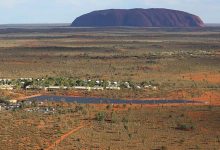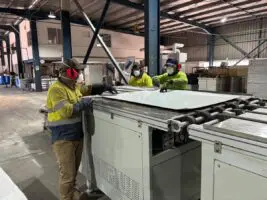The Northern Territory sounds like it should be a fantastic place to be in the solar business.
Not only does it boast some of the best solar resources in the world, it has a local government that aims to source 50 per cent of its power needs from solar in little more than a decade.
The scale of the opportunities in the Northern Territory has been underlined by the decision of two of the country’s richest men – Mike Cannon Brookes and “Twiggy Forrest” to join, and fund, the Sun Cable consortium that wants to build the world’s biggest solar farm (10GW) and the biggest battery (22GWh), and send much of the output to Singapore via a 4,000km submarine cable.
What more could you possibly want? Quiet a lots it turns out, because – as is often the case in the Top End – not all is what it seems, or what it should be.
There are major power plays in train that pit generations of power engineers against the other over how the energy transition could, or should be played out, and bitter battles between key energy institutions. The electrical trades union is on the warpath over the loss of jobs and outages in the Alice Springs network, and the government appears unsure how to react.
This week, the worst fears of many in the renewable industry were confirmed when the Utilities Commission, the local regulator, largely endorsed a proposal from the network owner, the Power and Water Corporation, that imposes strict new conditions on new solar farms that may make most of them unviable and will add around 30 per cent to their costs.
Many wind and solar developers in other parts of Australia’s grids have complained about strict new standards imposed on their projects, but they are nothing compared to the draft new generator performance standards to be imposed on new solar farms in the grid that serves Darwin to Katherine.
This includes a requirement to be a “fully scheduled” generator rather than semi-scheduled, which comes with strict rules about forecasting (accurate predictions 30 minutes ahead on a rolling 5-minute basis), strict ramping requirements and the need for battery storage.
According to the Utilities Commission draft report, this would mean each solar farm would have to install a battery with the equivalent of 80 per cent of its capacity, and storage for that amount for at least 30 minutes.
That translates – for a 25MW solar farm, such as the one currently under construction by ENI in Katherine – into a 20MW/10MWh battery, which the commission says could cost $10 million or more, or add nearly 30 per cent to the cost of the project.
We think that’s a low ball estimate of the costs of a battery of that size in such remote regions, particularly when you include installation and connection costs. And, rather cutely, the commission says that battery storage costs are predicted to come down in coming years. “So there is significant economic benefit in delaying investment until the need is proven,” it notes.
Renewable energy developers are outraged, others are simply appalled. “These would be the most onerous generation performance standards in Australia, if not the world,” said one expert, who asked not to be identified. “They have not been attempted anywhere else.”
The need for battery storage is not disputed, but the industry, and others, have argued that the smartest and cheapest solution is a “centralised” battery that could perform multiple tasks.
But this has been rejected by the Utilities Commission, largely because the forecast accuracy requirements (in which solar farms are penalised if their output varies by more than 0.5 per cent) means they would have to have a battery on site.
It concedes that this would add a “considerable” financial cost to the solar projects, and it will apply to all solar projects fo 2MW or more. PWC estimates there is a queue of around 120MW of new solar projects applying for connection to the grid.
Worse, the new standard – if approved next year – will be retrospective and will apply to all solar farms completed after April, 2019. That includes the 25MW Katherine solar farm that is nearly commissioned, and the smaller 12.5MW Manton and Batchelor solar projects that are also ready for construction.
All are owned by ENI Australia, a subsidiary of the Italian oil giant which completed the purchase of the two solar projects just two months ago.
ENI, which also has an interest in the huge Bayu-Undan gas field and the Darwin LNG plant, and which made $4 billion in profits last year, and should be able to flex some considerable economic muscle, said it did not wish to comment.
However, it pointed RenewEconomy to the press release announcing the purchase of the smaller solar farms, where it referred to “innovative cloud coverage predicting technology” that would minimise impacts to the grid.
It is not clear if this will be enough to avoid the need for significant battery storage. At Katherine, it already has a 5.7MW/2.9MWh battery, and while the Utility Commission decision does allow some “wriggle room” for solar developers, any variation of the GPS has to be negotiated with PWC which proposed them in the first place.
Some say this is part of the problem with the NT, being so small the network owner PWC doubles as the system controller. That gives it an inordinate amount of power of decisions and operations.
One of the key institutions favouring a centralised battery is Territory Generation, which operates the fleet of gas-generators that dominate the grid, as well as providing ancillary services to keep it stable. It issued a tender for a battery way back in 2017 and remains in talks with the government over the project.
CEO Tim Duignan says T-Gen still wants the battery – potentially sized at around 35MW and with 35 minutes of storage – to help it deal with the comparatively huge amount of rooftop solar, which stands at 70MW and is growing quickly and, which is uncontrolled and not covered by the GPS.
And it’s contributing to the growing “duck curve” in the Darwin Katherine grid.
Duignan says that 2019 has already witnessed in some events where gas generators need to rapidly increase generation (as clouds cover the skies) and then rapidly decrease (as temperatures fall and air-con systems get switched off).
The gas generators are struggling to cope, and the battery would be sized for 35 minutes storage because that is the time it takes for the gas generators to react. It would operate in much the same way as the Alinta battery next to the Mt Newman gas generators in the Pilbara, which has saved fuel costs and lifted reliability.
But Duignan also says a centralised battery would have helped to ease the constraints on the link between Darwin and Katherine, where most of the proposed solar farms would be cited. Having batteries installed at the solar farms in Katherine would not ease those constraints, and so limit their output.
Ilana Eldridge, director and project manager NT Solar, the only local renewable developer on the NT Grid, and which is currently preparing to construct the territory’s largest solar farm, a 50MW facility at Livingstone near Darwin, says she is disappointed the Utilities Commission has largely ignored the advice of the industry and generally accepted most of PWC’s proposed changes.
“Clearly there’s tension between the NT Government’s policy aspirations for 50% renewables and the gatekeeper, the Power Water Corporation,” she said in a statement.
“The additional costs flowing from the GPS changes will deter investment in an emerging local industry that would create hundreds of jobs and lower costs of electricity for Territorians.”
Eldridge supports the idea of the centralised “big battery”, which she says could be built in a public/private partnership and save costs.
“This would be a win/win – the government would save money, the grid would be stabilised and Territorians will receive cheaper, reliable and clean power,” she said.
Alan Langworthy, the chair of the expert panel that produced the territory’s Roadmap to Renewables report, was highly critical of the Utilities Commission report and said it could throttle investment, and defeat the government’s own 50% renewable energy target.
“I am very disappointed at the government’s inactivity in implementing any of our recommendations of our report,” Langworthy told RenewEconomy. “That inactivity is manifest in things like the GPS coming out in a form that is in complete odds with the 50% renewable energy policy.”
In fact, there is widespread criticism of the lack of action from the Labor territory government, which despite committing to the 50 per cent renewable energy target has not taken an active role in the recent decisions, despite warnings by many in the industry.
“We’re disappointed at how, in the two years which have passed since the release of this detailed and concrete roadmap, we have seen little to no action of its 10 recommendations,” says Monica Tan, from Repower NT at the Environment Centre NT.
“Also proposed in that report was an independent implementation agency that could have coordinated the actions required for grid upgrades to renewables. If that agency was in place, no doubt we would have had a very different outcome today.
“With the Territorian elections looming in August 2020, we strongly encourage the Gunner government to revisit their Roadmap to Renewables report and make headway with implementation of its key recommendations.
“Otherwise the government will risk having little to show in regards to the urgent upgrades required to a grid that will soon struggle with ageing gas generation.”
Indeed, the territory government is accused by some of simply basking in the reflected glory of the extraordinary Sun Cable project. There is no doubt that would be a game changer not just for the territory, but the world at large. As Cannon-Brookes said recently, he sees it as a “lighthouse” project for the future.
But the local players warn that there is no guarantee that the Sun Cable project will go ahead, and any decision won’t be made for several years. And if it does go ahead, it could have implications for existing local generators, and organisations such as T-Gen.
In the meantime the local industry risks floundering in the wake of decisions that could make it all but impossible for smaller solar projects to proceed.
See also: Alice Springs: Solar city at centre of a fossil fuel controversy








